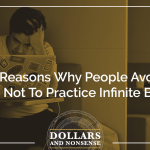In this episode, Nate breaks down the three main reasons why people who practice Infinite Banking end up with multiple policies. He explains what a MEC limit is, and what benefits you can get from insuring other people, like spouses, children, or even business partners.
Nate dives into how policies can be strategically used for different purposes, like covering taxes or supporting charitable causes. He ends the episode by emphasizing that the number of policies doesn’t matter as much as the total amount of premium being contributed.
Key Takeaways:
- 3 main reasons why people own multiple policies while practicing IBC:
- Every policy has a MEC limit, which determines the maximum amount of money that can be funded into it.
- Owning policies on other people, such as spouses, children, and business partners, can provide additional benefits.
- Policies can serve different functions, such as paying taxes or charitable giving.
- The number of policies doesn’t matter as much as the total amount of premium being contributed.
Episode Resources:
Gain FREE access to our Infinite Banking Course here
——————————————————————————————————————————
LIVING WEALTH PODCAST
DOLLARS AND NONSENSE: EPISODE 230 TRANSCRIPTION
Nate Scott [00:00]:
In this episode, I discuss the three main reasons why people end up owning multiple policies while they practice the process of infinite banking. I’m Nate, I make sense out of money. This is Dollars and Nonsense. If you follow the herd, you will be slaughtered.
If you’ve been around infinite banking for much time at all, you’ll hear people like me and people just all around talk about how many policies they own. I own 50 policies. I own 20 policies. I own one policy.
Nate Scott [00:33]:
Especially if you’re starting out, you’re like, what the heck is all this multiple policies thing? Is there something magical about owning multiple policies? I just have my one little policy, and they’re all saying they have 50 policies. Should I just open a whole bunch of them? A whole bunch of little tiny ones?
And I think this can be very confusing because some people think there’s some sort of magic in having multiple policies. So I’ll have some people say, Nate, I want to put in like $100,000 a year, but should I just do one $100,000 policy or should I do like five $20,000 policies? And I think that comes from this idea that there’s some sort of magic about having multiple policies.
So, here’s what I wanted to dive into today. The reality is 100% true. Almost everybody who practices infinite banking successfully will end up owning multiple policies. But it has nothing to do with the magic of divvying up your total capital outlays into policy or like divvying up your premiums into multiple policies. It actually has to do with like, there’s three main reasons, and I’m going to talk about those.
Nate Scott [01:34]:
There’s three main situations that would provoke additional policies being added to the system, and we’re going to dive into that. And it’s not very complicated at all. So if you’ve started IBC and you only have the one policy started with, or maybe you have one or two, and you’re hearing all these people, like, I personally, by the way, own twelve policies. Once again, nothing magical about having twelve. And that’s a big number to some people. That’s actually kind of small. Like, I’ve got clients that have way more than twelve policies. And so, by the way, you’ll figure out why, as we dive in.
Nate Scott [02:09]:
So the very first thing that we have to understand. So, point number one, the very first thing we have to understand whenever talking about why people own multiple policies is that every policy that’s purchased, this is the most common reason why someone will end up with multiple policies. And this is the reason why everyone should end up with multiple policies. If things go well. It’s all based on this one reason. So every policy that’s built has this thing called a MEC limit. It stands for, by the way, the MEC is M.E.C (Modified Endowment Contract). And the IRS has rules that govern how whole life insurance policies have to be designed in order to be called life insurance by the IRS and to be allowed to be tax free entities, essentially, or at least have the tax favorability of life insurance.
Nate Scott [02:57]:
And if they don’t pass this thing called the MEC test, it’s not called life insurance anymore. It would be called a modified endowment contract and it would open you up to new taxation issues. So of course, nobody wants to have a MEC. But how this comes into play on this multiple policies front is that every policy that you start has a limit of money that can fit in by how it was designed at the very beginning of the policy life.
And so how this plays out is you could show up and talk to me and say, Nate, I want to do infinite banking, I want to work with you and I want to put in $50,000 a year of premium or 20,000, whatever the amount is. This is the kind of policy that I want to start. So I want to start by funding my banking system with X amount of dollars, let’s just call it 50,000. So we have a client who’s going to put in 50 grand a year.
Nate Scott [03:46]:
We then have to go build that policy in such a way that it produces the most amount of value to the client and allows him to put the 50 grand in. Of course. So how you build the most efficient policy is actually by building the MEC limit, the max amount that can fit into the policy. You want that to be right in line with how much you really want to be funding into the policy.
So, in other words, if someone wants to open a $50,000 premium policy, you would typically design the policy where the MEC limit is right around $50,000. And the reason you do this is because any policy that you can pretty much max fund, that’s what that would be referred to. Like, hey, I built a policy that has a $50,000 MEC limit and I’m putting $50,000 a year into it. That max funding of the policy is really how you get the very most efficient policy design build that you could get.
Nate Scott [04:47]:
But this comes with some consequences. If you can read between the lines that if I started a $50,000 premium policy and I’m max funding it, but I actually have more resources, whether it’s additional cash flow or assets somewhere, or I have a windfall of money from some sort of event where maybe my income goes up, or I expand my business, or I start a new business, and suddenly my $50,000 policy that I got started and I was able to max fund, now I have more resources that I can commit to building a bigger banking system.
So, we call that expanding the banking system, right. It would just be like any other business. If you have one business and it can produce X amount of units, $50,000 in our case. The banking business is producing dollars as our units, and that’s the max capacity for this factory. Then the only way to produce 100,000 units is to open another factory. And that’s kind of how it works with life insurance.
Nate Scott [05:41]:
There’d be no reason to open your $50,000 policy, but have it be separated into two or three smaller policies just for fun. There’s nothing magical about that, but as you get going in the system, it almost always occurs that people will start to, if they’re practicing this well, if they’re successful financially, I mean, of course, if some of these things come into place, that their first policy, their policy numero uno that has $50,000 of MEC limit will suddenly become too small, it won’t be able to fit as much money as they would like to fit into the system.
And so they expand into a second policy and they open policy number two. So the very first reason why people have multiple policies is mainly due to the fact that all of the ones that you’ll ever start have a MEC limit. And if you’re max funding that policy’s MEC limit, and you have more resources, the only other option to expand the system and be able to put those resources into policies is to go into a new policy and expand that way.
Some people may say, well, Nate, why don’t I just build a policy with a much bigger MEC limit so I don’t have to open new policies. The issue with that is that policies are always essentially to scale. So if you ended up opening a policy that had a $100,000 MEC limit, but you only wanted to put in $50,000 a year, and all that extra space was just there in case you were to fund it later, well, that’s actually going to affect the design of the policy to make it allow for $100,000.
Natt Scott [07:16]:
And if you were to never actually max fund 100 and you just were to put in 50 like you would thought you’d be able to put in anyway, then the policy. In other words, this is how I would put it. Building a policy that fits 100,000 when you actually only want to put in 50, will look less efficient than if you just built a policy for 50 and then funded it with 50.
And then adding the second policy to the mix later on down the road is typically what makes sense, because the idea is this, policies are to scale. So 250 thousand dollars policies added together almost identically equal a $100,000 premium policy to begin with. So there’s not much of a sense to build it in for some what if event. Maybe one day I’ll pay this full amount. So the first thing to understand is just the idea that MEC limits exist.
Nate Scott [08:05]:
Every policy comes with one pre built into it at the very design, at the very outset of the policy, you can build a policy with any mech limit that you want. But once it’s built, that’s the most that can fit into that policy. Our job as advisors is to try to get you the best looking, most effective, cash value rich policy that we can, based on your situation. So, if it’s something that you can put 50 grand in, then we’ll build it for that.
And if God is good, which he always is, and your means expand into the future, and you can do more than that down the road. Congratulations, now it’s time to potentially open a second or third policy and keep going down that track. And that’s been me, by the way, personally, when I say I have twelve policies, I actually have opened all twelve of these policies for one of these three reasons.
Nate Scott [09:52]:
I haven’t even gotten the other two yet. But one of the primary ones is, of course, when I first got started in this business as an agent, trying to get with passion about infinite banking, wanting to do this, I wasn’t making any money, I was brand new. So I started a small policy. But then as I became more and more successful earning more and more income, I had to, by necessity, open additional policies so that I could continue to capitalize my banking system based on how things were going in life financially overall. So, that’s the first reason.
The second one is that there are benefits of owning policies on other people at times. So if the first reason, the most obvious organic reason to open new policies was because you’re maxed out on the one you own, and you have more money and you want to put it in, it’s very common. It happens to almost everybody at some point along their infinite banking journey, where it’s time to expand just naturally, organically, because you love IBC and you want to put more into it.
Nate Scott [09:48]:
That’s the most common. But there are benefits to insuring other people just to begin with. So I’m married and I own policies on my wife. We have four boys, four sons. I own policies on all four of my boys. There are benefits to owning policies that insure other people than just yourself. So maybe you would be the person that has $50,000 of cash flow outlay you want to put in, or some sort of asset that you’d want to move in and start a $50,000 policy. What I mentioned in the beginning was that you wouldn’t want to divvy that up.
Nate Scott [10:23]:
Well, now I’m going to walk that back a tiny bit and say, well, what if you and your spouse both work and you want to have a policy on each of you? Because there is going to be a death benefit provided by the policies. There’s no way around it. I know in the infinite banking circles, we talk about how much we love the cash value, and that’s our primary focus, and that’s always the primary focus for infinite banking, but it’s going to come with a death benefit. And you may say, I want to have policies that I want to have other people in the family be insured with this.
So, of course, for me and my wife, I own plenty of policies on me, but I own plenty of policies on her as well, because, yeah, what would I do without her? She’s worth way more than any amount of injuries I could ever put on her. And the idea is I wanted to make sure, honestly, I wanted to make sure that if something was to happen to her, that if God called me to do it, I could step down from Living Wealth and become a full time stay at home dad. I wanted to have that freedom. So instead of buying all the policies on me, yeah, of course, we divvied them up a little bit.
Nate Scott [11:24]:
There’s policies on me and there’s policies on my wife. You don’t have to start there. So I’m the primary breadwinner. So I did start on myself buying the big policies on me, because I wanted to make sure that they, number one, were taken care of, for sure, the family was taken care of. But as I got my system, as the primary breadwinner built up, now it’s definitely time to, if I can, to open and insure other people in the family. Same thing goes for kids. So I love having a policy on my kids for multiple reasons. I mean, God forbid, if something was to ever happen to any of them once again, I would want as much time as I needed to grieve and mourn and just kind of get on with maybe a new trajectory in life of something so traumatic as a child dying.
Nate Scott [12:09]:
So having a policy there that covers them, that puts me a bit at peace, or at least I would know. Of course, money can never replace anything, any relationship at all. It’s almost weird for me to talk about it like this, but in my head, that’s what it was. It was saying, hey, there’s many reasons why.
But one of them was, yeah, I just want to make sure that if something happens to any of my children, that I have as much time as I could possibly need to unwind and get refocused and spend time with the Lord and all the things that I would need to do in that time.
Nate Scott [13:13]:
On top of the fact that these are things I want to give to them one day, of course. So I want to be able to fund policies on my kids. I want them to be able to use those policies as they get older, to maybe buy their first car, to go to school, to open a business.
Nate Scott [13:26]:
I mean, all these things that I hope they’re able to do one day, to have a policy that has their name on it, they’re, the insured that I can pass to them is priceless to me. So of course there’s going to be benefits to insuring other people. So if you talk to somebody and they have multiple policies, number one, it likely has something to do with their first policy not being big enough to hold all the money that they would end up wanting to put in.
Or maybe it was that they have policies on their spouse, their kids. And one thing I forgot to mention, too, is people will buy policies on their business partners, key employees. There’s these different avenues for you can own policies that insure other people for the benefit of having the insurance on somebody else in general. So that’s very, very common.
The last thing, and maybe the most complicated one to some degree, is that not only is that essentially policies can serve different functions, it’s human nature to want to reserve things and systematically set something up to help take care of yourself and to make sense of the world.
Nate Scott [14:32]:
So that idea would be like, it’s very common to have people who own a policy just for paying taxes each year. They start like a tax policy. I have to pay taxes every year, and I want to open a policy, and I’m going to fund it, save money into it, but I’m going to borrow from it and repay it each year to fund taxes each year. If you’re a business owner, entrepreneur or something like that, that has to write big checks to the government. Same thing. Some people do that with charitable giving, where it’s a policy set aside just for that.
I remember Ray would talk about this a lot, my mentor and the founder of Living wealth. He would talk about how he had policies for taxes and charitable giving only because these were things that recurred every year and he wanted to set those aside and not use those to make the investments in loans that he was making to other people.
Nate Scott [15:19]:
Because he owns a private finance company that made loans to a whole bunch of people. And essentially he overinvested one year and had reduced his liquidity. And then tax season rolls around. He gives a lot to charity at the end of the year. And he was like, it’s really tight right now. And that’s because he just had all of his policies all doing everything for him all the time. So he made that change and encouraged clients to make that change too, if they were using it for things like that. So essentially, it’s common that each policy can serve its own function.
Nate Scott [15:51]:
If you wanted to do it that way, it doesn’t have to be done that way. But if you want to do it that way, that can be helpful. People have found that to be helpful. Sometimes on top of that, even on a bigger scale, because people will use policy loans from policies, both personally to do personal things and business wise, to make investments and to grow businesses.
So, because you may use your policies in business and you may use your policies personally, it can be very helpful from an accounting standpoint to have some policies designated just for personal use and some policies designated for business or investment use. And the reason is because anytime we use the, and I’m not a tax advisor, so nobody jump through the– No one take my word for this.
Nate Scott [16:39]:
Talk to your own people. But what I’m saying is, from what we’ve been told by our tax people, that if you borrow against your life insurance policy and use it to loan money to your business or to make an investment of some sort, that the interest that you pay to the life insurance company can be tax deductible if used for those types of purposes. And this is not the–
I’ve done a podcast on that topic before. I’m not going to dive into that topic today. But what I’m saying is it can be nice to have policies set aside just for that. So it keeps things from getting confusing. And to have other policies that are done more personally, maybe to buy your personal car, to pay taxes, charitable giving, remodel the house, things that will be more personal of nature, that we’re not looking to deduct any interest per se, but to have other policies that are for business investment purposes.
Nate Scott [17:27]:
That essentially, you know that all the interest that you pay to those policies is always an expense, a tax expense, a deduction, interest expense against business or investment income. So it’s kind of nice if you were to mingle within one policy, personal use and investment use, you’re going to have to figure out how much of the interest that you were paying towards that policy was based on the loan you made personally or versus what was made to the business or to make the investment.
And it can just get kind of hairy. It’s not the end of the world. It just would require more record keeping, which is probably good anyway, but nonetheless, it would require more record keeping and accountability if you were going to do it like that. So here’s the three main reasons why people own multiple policies. One, every policy has a MEC limit. Because it has a MEC limit.
Nate Scott [18:17]:
You can’t fund more than the MEC limit. That’s the max that can go into any policy. You can build a policy with any MEC limit, but once you’ve built it at the very beginning, it’s set in stone. And so if you want to put more money in than your first policy will allow, then the only other solution is to continue expanding into additional policies over time.
That’s been my life from my first policy being a small one to my last policy being most of my last policies being six figures of premiums. I just have expanded the system as time has gone on, which is God has been good, and I hope he’s good to you, too. So that’s the first reason. The second one is that there’s just simply benefits of owning policies that insure other people.
Nate Scott [18:59]:
So, you may end up owning policies both on you and your spouse and your kids as time goes on. And that would be very, very good. So, there’s benefits of insuring other people, just in general, for many of the reasons that we talked about, even like key employees or partners, very, very common.
And lastly, some people will open policies that serve specific functions, that they open multiple policies that can do different things so they can set money into one to achieve one goal and set money into another to achieve another goal. And that can be a pretty commonplace thing as well.
What it’s not for is some sort of magic. Like in other words, if someone says they have 50 policies, but he’s only putting in five grand a year into all 50 on average, so that he’s putting in 250,000 a year, which is a big premium. But in other words, there’s nothing better about that guy’s scenario than just the guy who started one policy and put in 250 grand a year in premium to begin with.
Nate Scott [19:49]:
In other words, there’s nothing magic about having multiple policies. The number of policies doesn’t really matter. What matters is the total amount of premium that you’re contributing. That’s what will determine your overall wealth building success has nothing to do with the number of policies. It has to do with how much premium you’re actually able to fund into your banking system.
The more the merrier. No one’s ever complained about having too much money in the bank, so we definitely agree with that here. So the idea is there’s something magic about it, it makes sense, and everyone should aspire to have a system of policies.
Nate Scott [20:24]:
In IBC, it would be very rare for someone to end up only owning one policy and have it be good enough for the rest of their life. I found scenarios that often take place are the people who come with a bunch of capital already that they’ve saved up, or that they want to move in.
Maybe somebody already has a million dollars sitting in liquid capital and they’re just using that to fund a big policy where the MEC limit of that policy will probably be big enough for them to never need to open another policy down the road based on the MEC limit. In other words, once they’ve moved all their big liquid capital into it, their cash flow will never be able to even fill up the bucket all the way up to the max anyway.
So, in other words, there can be times where your first policy is so big because of situations, circumstances. If you’ve come in with like a windfall money and built a large policy where that might be good enough for you for the rest of your life, but technically, that still doesn’t mean that you might not enjoy benefiting from insuring other people or opening additional policies to do specific functions. So those two would always be open to everybody.
Nate Scott [21:27]:
But the reality is, most of the time it’s going to be a system of policies built for you to really achieve this, as well as just simply the fact that inflation exists and your income should hopefully go up over time, and there should hopefully be more premium dollars available over time. That’s it for today, that there are many reasons to own multiple policies. I own plenty, and it’s super fun to manage the system.
Oh, one more thing. I should have mentioned this beforehand, but I didn’t. The idea is also, it’s actually not that hard to manage multiple policies. If you talk to anybody who’s owned multiple policies, I’ll have questions from clients. They’ll say, like, Nate, is it harder to manage a whole bunch of them than it is to manage just like one? I’m like, not really.
Nate Scott [22:04]:
I mean, it’s really just not. I don’t even know how to describe it. I’m just merely saying I have twelve policies and it hasn’t been difficult in any way. It’s actually quite simple for me to manage and run multiple policies. It’s like having multiple bank accounts, a brokerage account, a stock account, a bitcoin account, a gold and silver account. I mean, it’s just like, we all have this and it’s not that hard. So the same thing kind of applies with infinite banking. So thank you guys so much for being here.
Nate Scott [22:27]:
Guys, by the way, if this podcast means something to you, man, the best way you can get the news out there is to like, subscribe, comment. Just let us know what your questions are, let us know how you’re doing, let us know if the content’s meaningful to you. That means the world.
It tells the algorithms that we are producing good content. So we’d love your help in boosting the show. And by the way, as we wrap this up, this is something that is a passion product for us. It’s totally free to do this, but we really do believe that we have the best infinite banking podcast out there. If you guys agree with that, we’d love support.
Nate Scott [23:03]:
With that being said, this has been Dollars and Nonsense. If you follow the herd, you will be slaughtered. And by the way, we do have a free course available at www.livingwealth.com/escapethebank that dives into infinite banking. And I believe it’s probably the best infinite banking course available on the marketplace to go from a to z and understand what we’re doing. So, www.livingwealth.com/escapethebank to get access to the free course. We’ll see you there.









